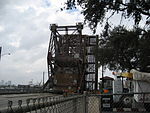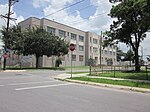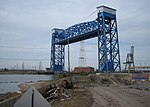Claiborne Avenue Bridge
Bridge disasters caused by collisionBridge disasters caused by maintenance errorBridge disasters caused by tropical cyclonesBridge disasters in the United StatesBridge disasters involving open moveable bridges ... and 7 more
Bridges completed in 1957Bridges in New OrleansLower 9th Ward, New OrleansRoad bridges in LouisianaTransportation disasters in LouisianaUse mdy dates from August 2023Vertical lift bridges in Louisiana

The Claiborne Avenue Bridge, officially known as the Judge William Seeber Bridge, is a vertical lift bridge in New Orleans, Louisiana over the Industrial Canal. It was built by the Louisiana Department of Highways (later renamed the Department of Transportation and Development) and opened to vehicular traffic in 1957. The bridge has suffered numerous disasters: A barge hit the bridge in 1993, Hurricane Katrina damaged it in 2005, and a car plunged into the canal in 2008 due to a malfunction.
Excerpt from the Wikipedia article Claiborne Avenue Bridge (License: CC BY-SA 3.0, Authors, Images).Claiborne Avenue Bridge
North Claiborne Avenue, New Orleans
Geographical coordinates (GPS) Address Nearby Places Show on map
Geographical coordinates (GPS)
| Latitude | Longitude |
|---|---|
| N 29.969096 ° | E -90.025734 ° |
Address
North Claiborne Avenue
70117 New Orleans
Louisiana, United States
Open on Google Maps







